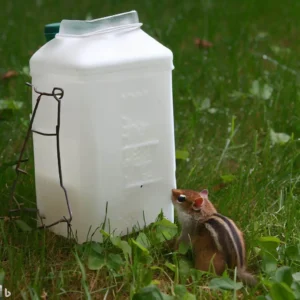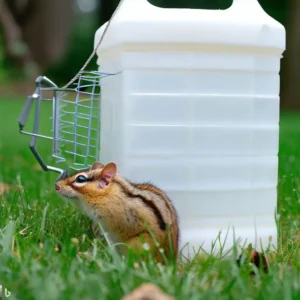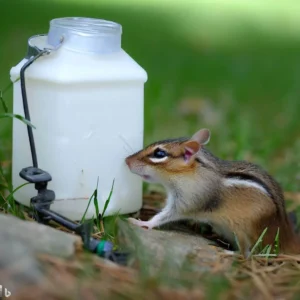How to Catch a Chipmunk with a Milk Jug in Easy Step-by-Step Guide
Chipmunks are adorable, but they may cause havoc in your garden or backyard. If you’re sick of these obnoxious rodents stealing your plants and causing damage, it’s time to take control. in Fiedurate.com we’ll show you how to trap a chipmunk with a milk jug using simple and practical methods in this article.
First, we’ll go over the process step by step and highlight several successful chipmunk control tactics that use a milk jug. Then, we’ll go over the supplies needed to make a chipmunk trap out of a milk jug, as well as how to construct the trap. We’ll also show you how to bait the trap to attract chipmunks and talk about how to avoid chipmunk damage when using a handmade trap.
Materials and Preparation
To catch a chipmunk using a milk jug, you will need a few materials:
| Materials | Tools |
|---|---|
| – One gallon plastic milk jug – Bait (birdseed, peanut butter, etc.) – Scissors – Gloves (optional) |
– Marker |
Once gathering your supplies, you can begin constructing the trap. To begin, cut a hole in the side of the milk jug using the scissors. The hole should be big enough for the chipmunk to get in but not so big that it can get out. Three inches in diameter is a nice size to aim for.
Next, choose the bait you’ll use to entice the chipmunk. Birdseed and peanut butter are common options. Use your marker to mark the location of the bait on the plastic milk jug.
Wear gloves if you want to prevent leaving human scent on the trap. This is especially critical if you are attempting to capture a very large animal.

Building a Chipmunk Trap Using a Milk Jug
To build the trap, simply follow these steps:
- With scissors, cut a hole in one side of the milk jug.
- Mark the opposite side of the milk jug using a marker where you will set the bait.
- Make a small hole in the milk jug’s lid. This allows you to inspect the trap without having to remove the cover entirely.
- Place the bait inside the milk jug, facing the hole you made previously.
- Make sure the lid is securely fastened.
- Place the trap in a location where you’ve previously seen chipmunks.
With these simple steps, you can easily create a homemade trap to catch chipmunks and control their population. In the next section, we’ll discuss how to bait the trap to ensure maximum success.
Baiting the Trap
The bait you use has a big impact on the success of your chipmunk trapping. In this section, we’ll show you how to bait the trap to catch chipmunks.
What to Use as Bait
Chipmunks are attracted to a variety of meals, so you have a choice of bait possibilities. Some popular choices are:
- Peanut butter
- Seeds (such as sunflower seeds)
- Nuts (such as almonds or walnuts)
Choose a bait that will fit inside the milk jug and will not spoil soon, as you may have to keep the trap out for several days before catching a chipmunk.
How to Place Bait
Place a small bit of bait in the bottom of the milk jug, being careful not to spill it out. To make it more appealing, put some bait on the inside of the jug walls.
How to Secure the Bait
To prevent the chipmunk from simply taking the bait and leaving without activating the trap, tie the bait to the bottom of the jug. You can accomplish this with a small piece of tape or adhesive. Make sure the bait is properly fastened so that the chipmunk has to climb or step on the trigger to get to it.
These steps will assist guarantee that your trap is properly baited and ready to catch any stray chipmunks.
Setting and Placing the Trap
Now that you’ve completed your milk jug trap, it’s time to position and set it up in the proper spot. Here are some pointers to make sure your chipmunk trapping is both safe and effective.
Select a strategic location.
Set up your milk jug trap in an area where you’ve noticed chipmunk activity. Look for burrowing or nibbling on wood or plants, as well as chipmunk noises. Place the trap in your garden in an area where chipmunks are commonly spotted hunting for food.
Set up the trap.
To make the trap available to chipmunks, place it on the ground and remove the cap. To prevent chipmunks from quickly entering or leaving the trap, make sure the bottom is level with the ground. You might also scatter some bait near the entrance to attract chipmunks.
Check the trap regularly.
It’s important to check the trap on a regular basis, ideally every few hours, to avoid trapping the chipmunk for too long. If they are stuck over an extended amount of time, they may suffer from stress, dehydration, and even death. Lift the lid of the milk jug and look inside to inspect the trap.
Release the chipmunk safely
If you’ve successfully caught a chipmunk, it’s time for you to gently release it. Handle the milk jug trap with gloves and release the chipmunk at least five miles away from your property in an area with lots of shelter and food. Avoid harming the chipmunk by gently releasing it.
You may use a milk jug trap to capture chipmunks securely and effectively if you follow these guidelines.
Checking and Releasing the Chipmunk
It is important to check your milk jug trap frequently to check if a chipmunk has been caught. Chipmunks can grow stressed if trapped for an extended period of time, thus it is critical to release them as quickly as possible.
To avoid surprising the chipmunk, approach the trap slowly and carefully. Wear gloves to protect your hands and stay away from the animal. To calm a chipmunk that has been caught, softly cover the trap with a cloth or towel.
To release the chipmunk, take the trap at least five miles away from your home or property. Step back and carefully open the trap, allowing the chipmunk to exit on its own. Handling or attempting to release the chipmunk by hand can cause unnecessary stress or injury to the animal.

Tips for Successful Chipmunk Trapping
Trapping chipmunks with a milk jug requires patience, attention to detail, and careful planning. Here are some tips and tricks to help you succeed:
- The location is key: Place the trap in areas where you’ve spotted chipmunks before. They love wooded places, bird feeders, and gardens, especially regions near rocks and stonewalls.
- Bait wisely: As bait, use peanut butter, sunflower seeds, or oats. Cheese and bread are ineffective against chipmunks.
- Timing is everything: Chipmunks are active during the day, so check your trap frequently. Chipmunks may perish from dehydration or heat exhaustion if the trap is left neglected for an extended period of time.
- Take note of the weather: Before setting up the trap, check the weather prediction. The efficiency of the trap can be reduced if the temperature is too high or too low.
- Using a decoy: If you’re having difficulties attracting chipmunks to the trap, try luring them in with a decoy. Before sliding the plate into the trap, place some bait on a plate near the trap to lure them.
- Release humanely: If you catch a chipmunk, handle it with care and release it at least five miles away from your house. Avoid harming chipmunks, as they play an important role in the ecosystem.
- Keep the trap clean: After catching a chipmunk, thoroughly clean the trap with soap and water. This will assist to avoid illness transmission and reduce any scents that may deter other chipmunks.
- Be persistent: Chipmunks are persistent animals, so don’t give up if you don’t catch one right away. Continue experimenting with different ways until you find one that works.

fieduraten is a proficient writer with expertise in SEO article writing. are also well-versed in the field of education, specializing in producing captivating content on topics related to education, scholarships, and games. With their exceptional skills, fieduraten crafts engaging articles that capture the readers’ attention and provide valuable insights in an informative manner. Whether optimizing content for search engines or delving into educational trends and opportunities, fieduraten’s writing prowess guarantees top-notch results.
